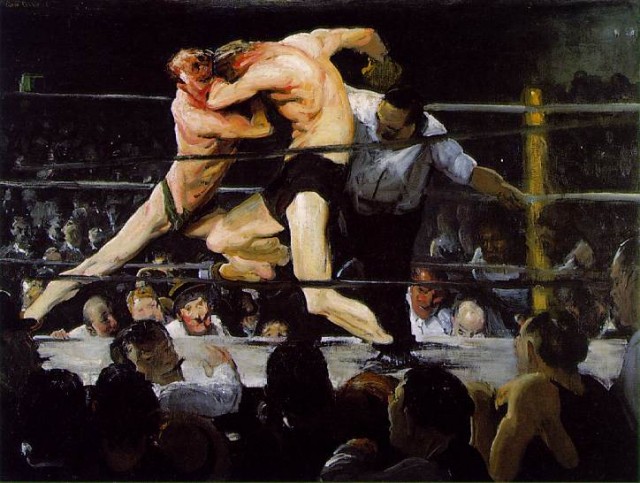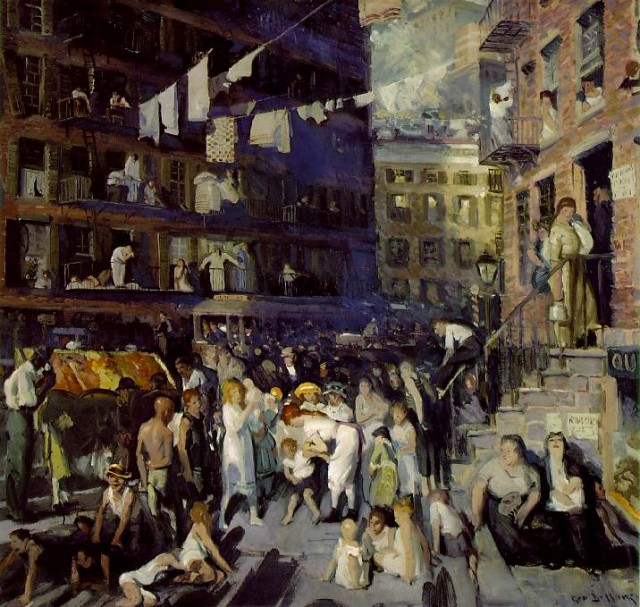
George Bellows, “Stag at Sharkey’s,” oil on canvas, 1909 (The Cleveland Museum of Art, Hinman B. Hurlbut Collection)
Metropolitan Museum of Art
Iris and B. Gerald Cantor Exhibition Hall, Gallery 999
1000 Fifth Ave. at 82nd St.
Through February 18, $25 adults, children under twelve free
212-535-7710
www.metmuseum.org
This is the last weekend to see the Metropolitan Museum of Art’s career-redefining exhibition on painter George Bellows. Simply titled “George Bellows,” the show explores the surprising diversity displayed by the Columbus, Ohio-born Ashcan artist who died too early, suffering a ruptured appendix and passing away from peritonitis in January 1925 at the age of forty-two. Bellows is best known for his spectacular boxing paintings, canvases that come alive with action and fury. In “Stag at Sharkey’s,” made during a period when boxing was illegal — Sharkey’s was a fight club across the street from Bellows’s studio on Broadway and 66th St. — every muscle and sinew bursts forth on the boxers’ bodies as they lunge at each other, the referee providing a visual counterbalance as the rapt crowd looks on. But Bellows, who moved to New York in 1904, was much more than a one-genre wonder. “Paddy Flanagan” is a striking portrait of a street kid, the palette and pose evoking the Old Masters. The darkness of “Forty-two Kids,” in which naked boys go for a dip on a ratty peer in the East River, stands in stark contrast to the bright, sunny “Beach at Coney Island.” Bellows’s creative process is examined in a series of sketches, drawings, and watercolors that result in the tour-de-force “The Cliff Dwellers,” which focuses on a busy, crowded street on the Lower East Side.

George Bellows, “Cliff Dwellers,” oil on canvas, 1913 (Los Angeles County Museum of Art, Los Angeles County Fund)
Bellows echoed Winslow Homer in such sea paintings as “Churn and Break” and “The Big Dory” and Pierre-Auguste Renoir in the family portrait “Emma and Her Children,” captured unique views of the Hudson River in “Pennsylvania Excavation” and “Rain on the River,” depicted high-end, grassy sports in “Polo at Lakewood” and “Tennis at Newport,” and detailed the horrors of war in general, and WWI specifically, in a controversial Goya-esque series featuring acts of violence that were later disputed. The show concludes with Bellows’s 1924 work “Dempsey and Firpo,” with Luis Ángel Firpo knocking heavyweight champion Jack Dempsey through the ropes and out of the ring at the Polo Grounds; the canvas is painted in a much more flat, graphic style than his previous boxing canvases made fifteen years earlier. A baseball player in college, Bellows learned about art primarily by visiting museums, including the Met itself, which served as a major influence on his work, so it is only appropriate that the Met is home to this must-see show, the first major career retrospective of the extremely talented, underrated artist since the mid-1960s and one that reveals him to be a masterful chronicler of life in early-twentieth-century America.